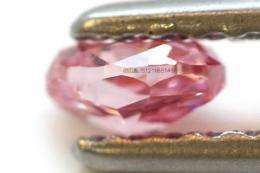Pink diamond 'behaviour' solved but colour still a mystery

UWA scientists have explained the photochromic behaviour of the pink diamond in an attempt to uncover why they possess their pink colouration.
Published in the journal, Diamond and Related Materials, the paper shows that the photochromic behaviour of the pink diamond can be explained by 'competing photoionization processes at multiple defect centres in response to an applied optical pump'.
Lead author and PhD student Keal Byrne says the team focused on why diamonds change colour under light.
"We have pumped these diamonds with various wavelengths of light and measured the response in both time and absorption intensity," Mr Byrne says.
"What we've seen is that the diamond colour—the amount of absorption that gives it the pink colour—is dependent on both the wavelength and intensity of the light, and what that is consistent with is a model of electron transfer between the unknown pink defect and other defects in the lattice," he says.
This research has shown the defect centres responsible for many diamond colours, do not explain how pink diamonds get their colour.
"Colouration in diamonds is due to crystalline defects in the crystal lattice, which are also known as colour centres as they induce colour," Mr Byrne says.
"The colour centre responsible for pink colouration is unknown."
The team investigated photochromism, modelling the pink diamond photochromic process as 'an optically-driven electronic transition between two (or more) separate defect trap states, one of which acts as a ground state for the 390nm and 550nm absorption bands'.
The paper identifies that the pink coloration arises from 'absorption bands centred at 550nm and 390nm. The depth of these bands can be reduced (the diamond can be 'bleached') under ultraviolet illumination of the diamond and can be restored with longer-wavelength light'.
"Defects introduce energy level transitions into this band gap that absorb invisible frequencies," Mr Byrne says.
"So we're trying to work out what these new energy levels are that are unique to the pink diamond and by that way we can work out what properties it has and what use it might have."
Mr Byrne says he is still interested in furthering this research to discover why this pink colouration exists and where it comes from.
"I'm happy that we've managed to describe its behaviour, but some big questions still exist and hopefully we can answer them," he says.
Journal information: Diamond and Related Materials
Provided by Science Network WA





















